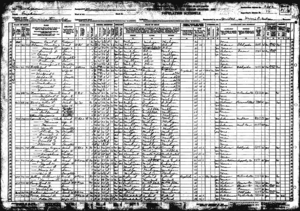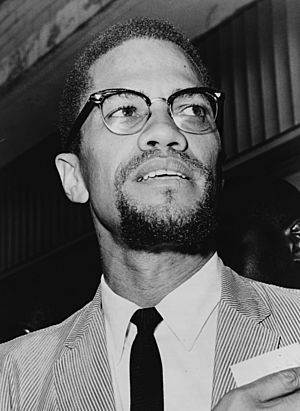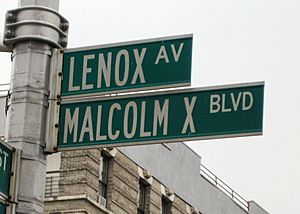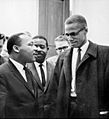Malcolm X facts for kids
Quick facts for kids
Malcolm X
|
|
|---|---|
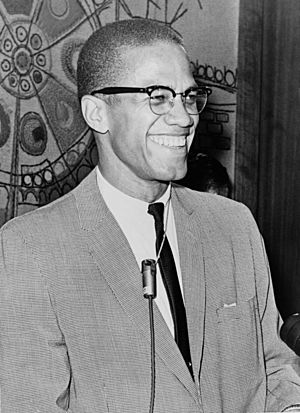
Malcolm X in March 1964
|
|
| Born |
Malcolm Little
May 19, 1925 |
| Died | February 21, 1965 (aged 39) New York City, U.S.
|
| Cause of death | Assassination (multiple gunshots) |
| Resting place | Ferncliff Cemetery |
| Other names | el-Hajj Malik el-Shabazz (الحاجّ مالك الشباز) |
| Occupation | Minister, activist |
| Organization | Nation of Islam, Muslim Mosque, Inc., Organization of Afro-American Unity |
| Height | 6 ft 3 in (191 cm) |
| Movement | Black nationalism, Pan-Africanism |
| Spouse(s) | Betty Shabazz (m. 1958) |
| Children | Attallah Shabazz Qubilah Shabazz Ilyasah Shabazz Gamilah Lumumba Shabazz Malikah Shabazz Malaak Shabazz |
| Parent(s) | Earl Little, Louise Helen Norton Little |
| Signature | |
 |
|
Malcolm X (born Malcolm Little, later Malik el-Shabazz; May 19, 1925 – February 21, 1965) was an important Muslim minister and human rights activist in the United States. He was a key figure during the civil rights movement, which fought for equal rights for all people.
Malcolm X was a spokesperson for the Nation of Islam until 1964. He strongly believed in empowering Black people and promoting Islam within the Black community.
Contents
Growing Up
Malcolm X was born on May 19, 1925, in Omaha, Nebraska. He was the fourth of seven children. His parents were Louise Helen Little and Earl Little. Earl was a Baptist speaker who admired Pan-African activist Marcus Garvey. Both of Malcolm's parents were involved in the Universal Negro Improvement Association (UNIA), a group that worked for Black empowerment.
Because of threats from groups like the Ku Klux Klan, Malcolm's family moved several times. They settled in Lansing, Michigan, where they were often harassed by the Black Legion, a White racist group. His father believed this group burned their home in 1929.
When Malcolm was six, his father died. His mother, Louise, worked hard to support the family. In 1938, Louise became very ill and was sent to a hospital. Her children were then separated and sent to foster homes.
Malcolm was a good student in junior high school. He attended West Junior High and Mason High School in Michigan. However, he left high school in 1941 before graduating.
From age 14 to 21, Malcolm lived with his half-sister Ella Little-Collins in Roxbury, a Black neighborhood in Boston. He worked many different jobs during this time. In 1943, he moved to Harlem, a famous neighborhood in New York City.
In 1946, Malcolm Little faced trouble with the law and was sent to prison. While in prison, he learned about the Nation of Islam, which changed his life.
Becoming an Activist
After joining the Nation of Islam in 1952, Malcolm X became a powerful voice for the group. He shared their teachings, which included the belief that Black people were the original people of the world.
Malcolm X had different ideas from the main Civil Rights Movement. While that movement worked to end racial segregation and achieve integration, Malcolm X believed in the complete separation of African Americans from White people. He suggested that African Americans should return to Africa. He also thought a separate country for Black people should be created in America.
He did not agree with the civil rights movement's focus on nonviolence. Instead, he argued that Black people should defend themselves and gain their rights "by any means necessary". His speeches deeply affected many African Americans, especially those in northern and western cities. They felt he truly understood their frustrations and spoke for them.
Malcolm X was a very important leader in the Nation of Islam. Many believe he was responsible for the group growing from a few hundred members to tens of thousands in the 1950s and early 1960s.
On March 8, 1964, Malcolm X announced he was leaving the Nation of Islam. He still believed in Islam but felt the Nation's teachings were too strict. He planned to start a new Black nationalist group to raise awareness among African Americans. He also wanted to work with other civil rights leaders.
After leaving the Nation of Islam, Malcolm X started two new organizations: Muslim Mosque, Inc. (MMI), a religious group, and the Organization of Afro-American Unity (OAAU), a group focused on Pan-Africanism. On March 26, 1964, he met Martin Luther King Jr. briefly in Washington, D.C. They were both there for a debate on the Civil Rights bill.
In April, Malcolm X gave a famous speech called "The Ballot or the Bullet". He told African Americans to use their right to vote wisely. But he also warned that if the government continued to deny them full equality, they might need to use other methods to achieve their rights.
His Death
Malcolm X was shot and killed in New York City on February 21, 1965. This happened while he was speaking about Black rights. Three members of the Nation of Islam were involved in his murder.
His Family Life
In 1955, Betty Sanders met Malcolm X after one of his talks. She soon started attending his lectures regularly. In 1956, she joined the Nation of Islam and changed her name to Betty X.
Malcolm X and Betty married in January 1958. They had six daughters:
- Attallah (born 1958)
- Qubilah (born 1960)
- Ilyasah (born 1962)
- Gamilah Lumumba (born 1964)
- Twins Malikah and Malaak (born 1965, after their father's death)
His Lasting Impact
Malcolm X is seen as one of the most important and influential African Americans in history. He helped Black Americans feel more proud of themselves and their African heritage. He also played a big role in spreading Islam within the Black community in the United States.
Many African Americans, especially those in cities, felt that Malcolm X expressed their feelings about inequality better than other leaders. One writer said that by speaking out about their frustrations, Malcolm X "made clear the price that White America would have to pay if it did not agree to Black America's fair demands."
In the late 1960s, many Black activists were inspired by Malcolm X's ideas. Movements like Black Power and the Black Arts Movement, and the popular phrase "Black is beautiful", all have roots in his teachings.
In 1963, Malcolm X began working with Alex Haley on his life story, which became The Autobiography of Malcolm X. He told Haley, "If I'm alive when this book comes out, it will be a miracle." Haley finished and published the book after Malcolm's death.
In the late 1980s and early 1990s, young people became very interested in his life again. Hip-hop groups like Public Enemy looked up to Malcolm X. His image appeared on T-shirts, jackets, and in many homes and schools. In 1992, the film Malcolm X, based on his autobiography, was released. In 1998, Time magazine called The Autobiography of Malcolm X one of the ten most influential nonfiction books of the 20th century.
Malcolm X also inspired several fictional characters. For example, the Marvel Comics character Magneto from the X-Men was partly inspired by Malcolm X.
Memorials and Tributes
Many places honor Malcolm X. The site of his first home in Omaha, Nebraska, is now marked by a historical marker. The Malcolm X—Ella Little-Collins House in Roxbury, Massachusetts, where he lived with his half-sister, was added to the National Register of Historic Places in 2021.
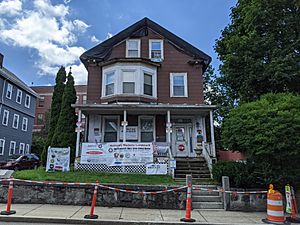
In Lansing, Michigan, there is a historical marker at his childhood home. The El-Hajj Malik El-Shabazz Academy, a public school with an Afrocentric focus, is located in the building where Malcolm Little went to elementary school.
Many cities celebrate Malcolm X's birthday (May 19) as Malcolm X Day. Berkeley, California, has recognized it as a citywide holiday since 1979.
Several cities have renamed streets after Malcolm X. In 1987, Lenox Avenue in Harlem, New York, became Malcolm X Boulevard. Other cities like Brooklyn, Boston, Dallas, and Lansing also have streets named after him. Even in Ankara, Turkey, a street was renamed Malcolm X Avenue in 2016.
Dozens of schools are named after Malcolm X, including Malcolm X Shabazz High School in Newark, New Jersey, and Malcolm X College in Chicago, Illinois.
In 1996, the first library named after Malcolm X opened in San Diego. The U.S. Postal Service even issued a Malcolm X postage stamp in 1999. In 2005, Columbia University opened the Malcolm X and Dr. Betty Shabazz Memorial and Educational Center at the Audubon Ballroom, where he was assassinated.
Portrayals in Media
Malcolm X's life has been shown in many films, TV shows, and plays.
In 1986, the opera X, The Life and Times of Malcolm X by composer Anthony Davis premiered. It was later performed at the famous Metropolitan Opera in 2023.
A documentary film called Malcolm X was released in 1972. Later, Spike Lee directed the 1992 film Malcolm X, starring Denzel Washington in the main role. This film was highly praised and appeared on many "best films" lists.
Other actors who have played Malcolm X include:
- James Earl Jones, in the 1977 film The Greatest.
- Dick Anthony Williams, in the 1978 TV miniseries King.
- Al Freeman Jr., in the 1979 TV miniseries Roots: The Next Generations.
- Morgan Freeman, in the 1981 TV movie Death of a Prophet.
- Mario Van Peebles, in the 2001 film Ali.
- Nigél Thatch, in the 2014 film Selma.
- Kingsley Ben-Adir, in the 2020 film One Night in Miami.
Published Works
Malcolm X's most famous book is his autobiography, which tells his life story:
- The Autobiography of Malcolm X. With the help of Alex Haley. New York: Grove Press, 1965.
Other books include collections of his speeches and writings:
- Malcolm X Speaks: Selected Speeches and Statements.
- Malcolm X Talks to Young People.
- By Any Means Necessary: Speeches, Interviews, and a Letter by Malcolm X.
- The End of White World Supremacy: Four Speeches by Malcolm X.
- The Diary of Malcolm X: 1964.
Images for kids
-
Muhammad Ali (born Cassius Clay) (second row, in dark suit) watches Elijah Muhammad speak, 1964
-
Malcolm X's only meeting with Martin Luther King Jr., March 26, 1964, during the Senate debates regarding the (eventual) Civil Rights Act of 1964.
-
Louis Farrakhan in 2005
See also
 In Spanish: Malcolm X para niños
In Spanish: Malcolm X para niños


